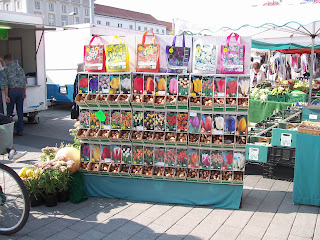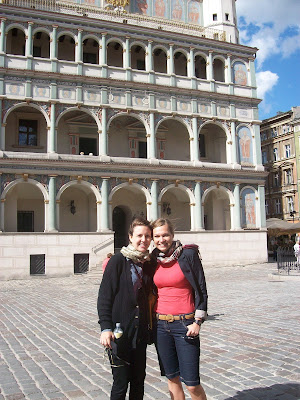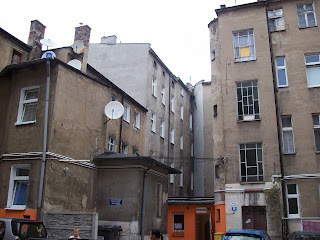 |
| Walk near University |
For the next few months, I will be taking some classes at the university. I'm looking forward to it, but I'm freaked out. I signed up for classes so that I can figure what kind of profession I want to go into, and can catch up on some requisites. The picture taken below is on my walk back from the university along a side street after matriculating. Below is the building in the above picture, seen more closely. The building was built using plate material. It doesn't look like a typical Plate building now though because the "green" in front of the building has been turned into parking.
That reminds me of the "Office Parks" in the US, which, when first developed, were supposed to offer workers a view of rolling hills and green surrounding their offices. In actuality, the green was sacrificed for rolling, meandering parking lots and roadways. But, I digress. The picture speaks for itself. It was a beautiful day!
The next picture, below, really shocked me! It was taken as I approached the Old-City, on a very vibrant street with lots of cool restaurants and bars. The shocking thing is that there is a wooden star of david tied to the little balcony toward the top of the house. I tried to zoom in, but I don't think it turned out. Whenever I see anything Jewish in Germany, like the remains of old synagogue, a jewish graveyard or a star of david (should that be capitalized?), I always pause to think about the situation. I mean, it isn't common to see Jewish things in Germany.
Interestingly, Lars always remarks when he hears or sees a last name which is Jewish-German. Be it in a film or book, be it an American or a German, or a name on an advertisement, he seems to know if the name is Jewish-German. I asked him, "How do you know the names are Jewish?" He answered, "The Jewish names are prettier." "Really???," I ask. "Yeah... I don't know why." It seems strange to me that the names should be "prettier." An example is "Rosenblatt", or Roseleaf, the name of the craftsman we met yesterday, who showed us some antique furniture. Roseleaf is a very pretty name!
 |
| House with Star of David on the balcony |
 |
| House on vibrant street, near Old-City |
These market stalls appear and disappear on the day of the market. It's hard to believe how big a space can seem when it gets crowded! I mean, this little plaza seems so small most days, but so many little stalls can fit in here for the market; you would think it is a very big place!
I guess that is how downtowns and dense cities work and end up seeming so big. The space can be so small, but can fit so much, that you think it is much "bigger" than it is! (On a side note, I remember the first time I walked across Center City in Philadelphia. It only took 30-45 minutes! So much in such a small space. I couldn't believe how small it is, when it always seemed so big.)
There are numerous markets in the Old-City. This one is only Wednesdays and Fridays. Another one is on Tuesdays, and another on Saturdays. The market square is in front of the Town Hall "Stadt Halle" and Courthouse "Rathouse." Directly next to the square is a shopping mall, so to speak, but it is more of a glassed in shopping passage. Isn't that an interesting idea? Instead of a parking lot in front of the mall, have a market!
Street markets are so common in Europe. I took the pictures below to show the types of things bought and sold at the market. They are so particular, that I chuckled from time to time.
 |
| Wednesday Market in Front of Stadt Halle |
 |
| Vendor selling kitchen supplies- I bought a strainer! |
 |
| Flower Bulbs for sale |
 |
| Fruits and Vegetables for sale |
 |
| Shoes and Slippers for sale to the right |
 |
| Autumn Plants and Flowers/Grasses |
 |
| Currywurst and .... Pantyhose? Ok! |
 |
| Meatwagon |
Sausage, ham, and all kinds of bologna, sometimes also some pickled meats like pickled fish, or some type of spiced pate or Leberwurst are commonly on display for buyers. Beef and chicken is not so common. It may seem strange to see so much pork for some Americans, but at least you don't see heads, legs or other less appetizing animal parts, as is common in lots of the world, I hear (certainly in Spain!). Below is a Stall selling Spices, 250 Sorts to be exact.

 |
| Spree Gallerie (Shopping Mall) |
Overall, I think it is really fantastic that, at a street market, many people can still make a living selling one particular thing at different markets. Aren't all markets the same the world over, whether in Jeruselum, Lyon, London or Philadelphia? Is this not the epitome of entrepreneurship, the foundation for how the modern free-market economy evolved into it's modern self? I think so, but I'm no expert. But I wonder why markets hardly exist in the US, but are abundant in the social-market economy in Germany? Is the root of the problem more economic in nature or is it a problem of urban design?
I am reading a book online called Unplanning: Livable Cities and Political Choices by Charles Siegel. He commented on this relationship between non-traditional home choices (outside the city) and real estate prices after WWII.
"We often hear that suburbia expanded so quickly only because people wanted to live there. It is true ...that many people wanted to take advantage of postwar prosperity to buy their own houses. But there is no reason to think that they wanted houses in postwar suburbia, designed according to the planners' principles, rather than similar houses in neighborhoods designed like old-fashioned streetcar suburbs.
In fact, the data we have shows that most of the people who moved to the new postwar suburbs did not particularly want to live in this sort of neighborhood. When Herbert Gans interviewed the residents of Levittown, a name that was symbolic of the mass suburbs of the fifties, he found that 72% of them had moved there for reasons that had nothing to do with its suburban setting. ...But streetcar suburbs were not being built at the time because they were not allowed by zoning laws."
-Charles Siegel
So what came first: the economic problem or the urban design problem? It is food for thought.
Speaking of food, I realize that a lot of the food at the market is imported from other countries, especially the vegetables, so the market isn't a market for local goods, necessarily. Street markets don't have to be local, and they aren't anti-globalization, per sé. Moreover, my favorite market experience was when the french marketeers visited St Albans in England for a week (such delicious cheese, bread, olives and sausage!!) But still, I like markets because I feel as if the person selling me a product is profiting from my business, and cares about my business. No offense to workers at chain stores, but sometimes they have a glassed-over look in their eyes, and I can tell they aren't thinking about me at all, just thinking about how long until they can clock out. It is a nice feeling to know that my business at the market is helping someone become a small business owner. Unfortunately, the prices can be higher. But they aren't are the German market in Cottbus. The market is just an alternative to the mall.
I ask myelf sometimes what kind of world my kids will grow up in. Will there still be small markets, small businesses and the option of a personal connection to where our food comes from in Germany and in the US? Lars says that he thinks so, at least in Germany. We talk about economics and quality of life a lot. Germans don't make as much money and pay very high taxes, after all. But, so many basic things are lacking n the US, like small markets. They are becoming fashionable in American dense residential areas, but these dense urban centers are so expensive, that only "richer" people, for lack of a better word, can afford to live there. That phenomenon is called gentrification.
Oh well. I enjoyed the market very much! I plan to become a regular at the Baker's Stall with the crusty bread.
 |
| The Mall that feels like a street. |














































